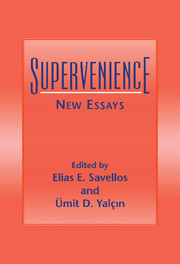Book contents
- Frontmatter
- Contents
- List of Contributors
- Introduction
- Varieties of Supervenience
- Supervenience: Model Theory of Metaphysics?
- “Global” Supervenient Determination: Too Permissive?
- Weak Supervenience Supervenes
- The Tweedledum and Tweedledee of Supervenience
- Reduction in the Mind of God
- Psychophysical Supervenience, Dependency, and Reduction
- Supervenience Redux
- Nonreducible Supervenient Causation
- Physicalism, Supervenience, and Dependence
- An Argument for Strong Supervenience
- Arguments for Supervenience and Physical Realization
- Supervenience and the Essences of Events
- How Does Ontology Supervene on What There Is?
- Supervenience and Intentionality
- Supervenience, Coherence, and Trustworthiness
- Does Truth Supervene on Evidence?
- Index
Reduction in the Mind of God
Published online by Cambridge University Press: 29 March 2010
- Frontmatter
- Contents
- List of Contributors
- Introduction
- Varieties of Supervenience
- Supervenience: Model Theory of Metaphysics?
- “Global” Supervenient Determination: Too Permissive?
- Weak Supervenience Supervenes
- The Tweedledum and Tweedledee of Supervenience
- Reduction in the Mind of God
- Psychophysical Supervenience, Dependency, and Reduction
- Supervenience Redux
- Nonreducible Supervenient Causation
- Physicalism, Supervenience, and Dependence
- An Argument for Strong Supervenience
- Arguments for Supervenience and Physical Realization
- Supervenience and the Essences of Events
- How Does Ontology Supervene on What There Is?
- Supervenience and Intentionality
- Supervenience, Coherence, and Trustworthiness
- Does Truth Supervene on Evidence?
- Index
Summary
Bertrand Russell (1924) placed at the heart of his logical atomism what he called “the supreme maxim in scientific philosophizing”: “Wherever possible, substitute constructions out of known entities for inferences to unknown entities” (p. 326). Rudolf Carnap took this maxim as his motto in explicating the logical structure of the world (1967, p. 5). Twentieth-century metaphysicians have often adopted Russell's maxim tacitly in pursuing reductive strategies.
In an increasing variety of areas, however, a consensus has grown that such strategies face dim prospects. We are still novices at neuroscience, but philosophers of mind no longer have much hope of reducing mental language to physical language. Physics has not yet found a unified theory of basic physical phenomena, much less a theory unifying them with the manifest image of the world, but philosophers of mind have lost faith that our everyday discourse about the world around us will eventually reduce to the language of an ideal physics.
A loss of faith in reduction has not led to a revival of faith in dualism, for its postulation of a realm of immaterial mental entities that have causal powers to affect each other and the material world seems unscientific and without explanatory power. To many, physicalism has remained the only respectable attitude toward the mind–body problem. The challenge has been to find a nonreductive physicalism that resists any commitment to immaterial entities while allowing that psychology and other higher-level theories are autonomous from physics.
- Type
- Chapter
- Information
- SupervenienceNew Essays, pp. 124 - 139Publisher: Cambridge University PressPrint publication year: 1995
- 2
- Cited by



